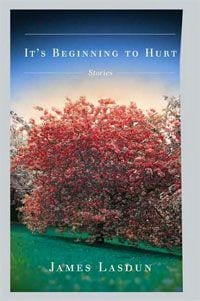
In It’s Beginning To Hurt, James Lasdun has created exactly the collection one might expect from an Englishman relocated to New York. Each story is excruciatingly subtle yet startlingly vibrant. His writing is a jungle: colorful, decorative and endless, with undiscoverable layers and secrets, and his gift with language extends far beyond the inventive usage of mere words.
Lasdun’s writing has its own very unique rhythm, one that serves to move the plot and content of his work, and mirrors the minds and behaviors of his characters. That rhythm may in fact be the only constant in the entire collection. Each story and character is remarkably individual and particular, revealing an imagination that seems to know no end.
His characters are male, female, old, young, spiritual, and morally decrepit. They live in cities all over the world. They travel, they relocated, they remain immovable. They deceive, they expose. Lasdun’s comfort in his own writerly skin enables him to stretch the material far and wide. He can be prim and proper, or use flippant slang.
Like Alice Monro, he creates a world inside each story. He is so adept with emotions that plot often seems irrelevant because we become so embedded in the minds of his characters.
In “The Incalculable Life Gesture”, we are lead to believe that protagonist Richard has lymphoma. The timeframe of the story is actually quite short. And the journey is in Richard’s mind as he transforms into a cancer patient and begins to think like one. But the cancer is merely a backdrop for the true disease in Richard’s life: his relationship with his family, his insecurity about his home, and his unease with his place in the world.
As is the case in many short stories, often very little changes in an obvious way from beginning to end. But whereas in many short stories, an author will signify that a character is forever altered by some small inconsequential thing, most of Lasdun’s stories seem to leave the characters exactly where they started. Yet in the process, he utterly transports the reader.
Conversely, when epic changes do occur for the characters, they are so tenderly and innocuously placed that one might have to re-read a passage to confirm the truth of the event. In “Cranley Meadows”, an older college professor and his young wife struggle with layoffs at the college while facing the future with the twin sons they are expecting. The story is a bridge linking a common shared experience and an excruciatingly unusual tragedy. The story’s events are stunning, but the characters remain quietly consistent in their attitudes, expressions and behaviors.
Yet somehow, there is never a dull moment in one of the stories. Each story moves quickly and compellingly and the entire collection flies by. Although his subject matter is always relatively serious and often dark, Lasdun’s style is playful and engaging. What is more is that he always seems to be on a wavelength with the truth of the moment, both externally and internally. His books have been adapted for the screen, and there is a meandering, easeful, movie-like quality to his writing.
The story that differs the most from all the rest is “Oh, Death”. Although the narrator is a well-to-do member of the middle class like most of Lasdun’s characters, the main subject of the story is a gun-wielding, Harley-Davidson-riding handyman, Rick, whose struggles with his wife and career are unlike any others in the collection. Lasdun’s ability to enter the realm of the uninsured, underemployed handyman worker is impressive, as his ability tell the story with a serious level of intellectual exploration.
Perhaps it is Lasdun’s simple conviction in the worthiness of troubled moments that enables him to treat each one out of a broad range of characters with similar care. Ultimately, Lasdun finds the pain, discomfort and dissatisfaction of every person, even those who are allegedly successful. One of the more uncomfortable stories is “A Bourgeois Story”, in which a man’s old Trotskyite college roommate reenters his life and casts a dark but ultimately harmless shadow over his whole life as a lawyer. In a few deft words, Lasdun cuts the insides out of his narrator, Paul. The reader is left with the uncomfortable feeling of being alone in the room with a corpse.
And that is Lasdun’s greatest ability: to make the reader part of world he creates. It’s Beginning To Hurt is what all fiction should be: a riveting intervention that simultaneously takes us away from real life, yet plunges us into real lives imagined. Indeed, it is the reality present in his writing that makes it so easy for us to leave our own lives outside the binding.

![Call for Papers: All Things Reconsidered [MUSIC] May-August 2024](https://www.popmatters.com/wp-content/uploads/2024/04/all-things-reconsidered-call-music-may-2024-720x380.jpg)



